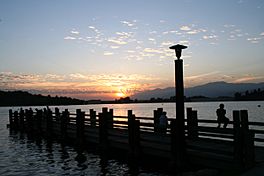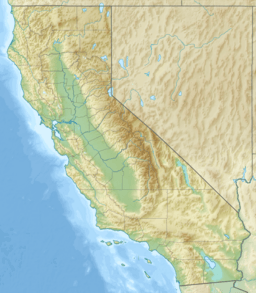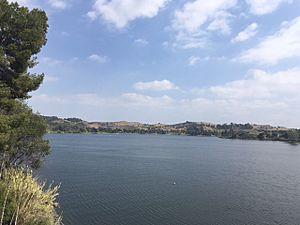Puddingstone Reservoir facts for kids
Quick facts for kids Puddingstone Reservoir |
|
|---|---|

Sunset
|
|
| Location | Los Angeles County, California |
| Coordinates | 34°05′25″N 117°48′31″W / 34.09028°N 117.80861°W |
| Type | reservoir |
| Basin countries | United States |
| Surface area | 250 acres (1.0 km2) |
| Surface elevation | 942 ft (287 m) |
Puddingstone Reservoir is a large, man-made lake in Los Angeles County, California. It covers about 250 acres (1 square kilometer). The lake is located near the Orange Freeway (State Route 57) and the San Bernardino Freeway (Interstate 10).
Many fun activities happen here, like fishing, swimming, sailing, and camping. The lake is part of Frank G. Bonelli Regional Park. Popular places like Raging Waters water park and Fairplex (where the Los Angeles County Fair is held) are right next to the reservoir.
The lake was created by building the Puddingstone Dam. This project started in 1925 and finished in 1928. The dam was built by the County of Los Angeles Flood Control District. Its main job was to control floods and store water for the area. Later, a road was built across the dam in 1932. This road made it easier to travel between nearby towns like San Dimas and Pomona.
In the past, Puddingstone Reservoir also supplied water to local farms that grew citrus fruits. People soon started using the lake for fun activities too. Today, the road over the dam is still used and is called Raging Waters Drive.
Contents
History of Puddingstone Reservoir
Why Was the Dam Built?
The area around Puddingstone Reservoir used to be dry, with only natural springs providing water. As more people moved in, there was a greater need for water storage. In 1923, the County of Los Angeles bought land to build a dam. The goal was to hold back floodwaters from a large area.
Building the Dam
Work on the Puddingstone Dam began in February 1925. It was a big project that cost one million dollars. The dam was finished in January 1928. It was built to control floods and help refill underground water supplies. The dam created the 250-acre lake we see today.
From Flood Control to Fun
- In 1931, the county started assigning lifeguards to the lake. This was because fishing and swimming were now allowed.
- A road was built across the dam in 1932. This made travel easier between San Dimas and Pomona.
- In 1948, a parking lot was added for visitors.
- By 1953, Puddingstone Reservoir was officially named a "Recreational and Fishing Area." The state even started stocking it with fish.
- In 1958, the county arranged to buy extra water for the lake. This helped keep the water level steady, which was great for recreation.
- The Frank G. Bonelli Regional Park was created around the reservoir. This park now covers almost 2,000 acres.
- In 1959, the county took over managing the Puddingstone area. A patrol boat appeared on the lake, and a boat house was built.
- Volunteers planted over 10,000 trees in the park.
- Water skiing became a popular activity along the east side of the lake.
- By 1972, the north shore of the lake had a swim park (which is now Raging Waters). It also had a place for powerboats to launch and picnic areas.
- By 1976, the south shore had places for sailboats to launch and more picnic areas. The Mountain Meadows Golf Course was updated, and an RV park opened.
Activities at Puddingstone Reservoir
Puddingstone Reservoir is a great place for many outdoor activities. You can go fishing, swimming, sailing, and even jet skiing or wind surfing. There is a special area on the north shore where you can launch your boats.
Fish Advisory
It's important to know that the California Office of Environmental Health Hazard Assessment has given advice about eating fish from Puddingstone Reservoir. They suggest being careful because some fish might have higher levels of certain chemicals. It's always a good idea to check the latest safety information before eating fish you catch.





